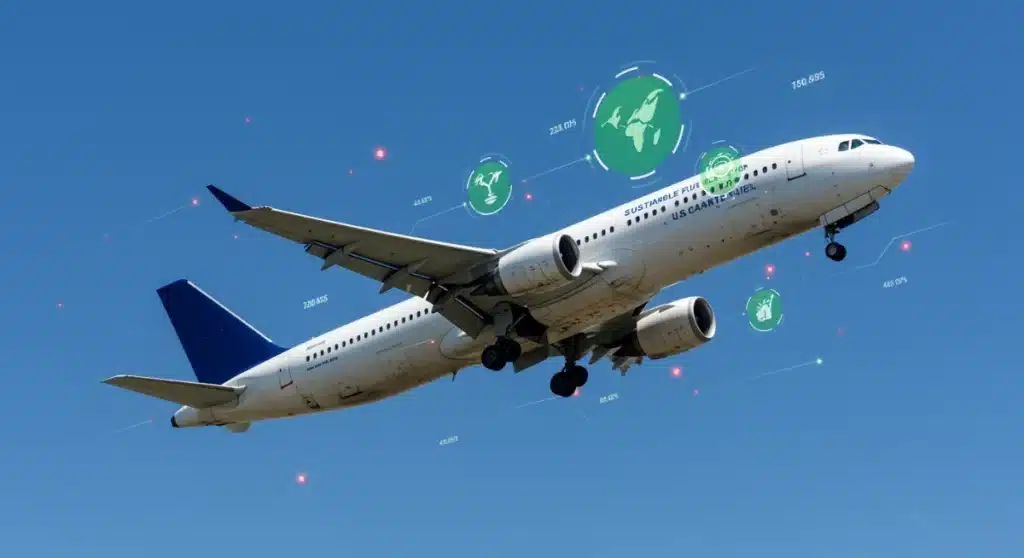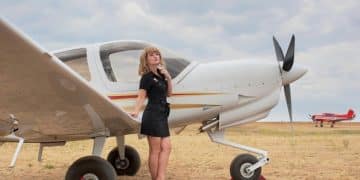SAF Mandates 2025: U.S. Airline Financial Impact

The 2025 Sustainable Aviation Fuel (SAF) mandates will significantly reshape the operational and financial landscape for U.S. carriers, demanding strategic investments and innovative solutions to meet environmental goals and navigate evolving market dynamics.
The aviation industry stands at a pivotal juncture, grappling with the urgent need to decarbonize while maintaining profitability. The impending Sustainable Aviation Fuel: Analyzing the 2025 Mandates and Their Financial Implications for U.S. Carriers presents both a significant challenge and a transformative opportunity. As the deadline approaches, understanding the nuances of these regulations and their potential economic ripple effects becomes paramount for airline executives, investors, and policymakers alike.
Understanding Sustainable Aviation Fuel (SAF)
Sustainable Aviation Fuel, or SAF, represents a critical pathway to reducing aviation’s carbon footprint. Unlike traditional jet fuel derived from fossil sources, SAF is produced from renewable resources, offering a more environmentally friendly alternative. Its development and widespread adoption are central to global efforts to mitigate climate change within the aerospace sector.
SAF is not a single product but a category of fuels made from various sustainable feedstocks. These can range from agricultural waste and used cooking oil to municipal solid waste and even captured carbon. The diversity of these sources highlights the innovative approaches being taken to create a viable, scalable solution for greener air travel.
Types and Production Pathways of SAF
The production of SAF involves several distinct pathways, each with its own advantages and challenges. The most common method currently is the Hydroprocessed Esters and Fatty Acids (HEFA) pathway, which utilizes fats, oils, and greases. Other emerging technologies include alcohol-to-jet (ATJ), gas-to-liquid (GTL, using biomass or waste gases), and power-to-liquid (PtL), which converts renewable electricity and captured CO2 into fuel.
- HEFA: Utilizes waste oils and animal fats, currently the most commercially available SAF.
- ATJ: Converts alcohols like ethanol or isobutanol into jet fuel.
- GTL/BtL: Transforms biomass or waste gases into liquid fuels.
- PtL: A future-oriented pathway using renewable electricity, water, and CO2.
Each pathway requires specific infrastructure and processing, influencing the cost and scalability of the resulting fuel. The environmental benefits of SAF are substantial, promising up to an 80% reduction in lifecycle carbon emissions compared to conventional jet fuel, depending on the feedstock and production method. This makes SAF a cornerstone of the aviation industry’s sustainability strategy.
Understanding the different types of SAF and their production methods is crucial for assessing their potential impact. The technological advancements in this field are rapid, continuously expanding the possibilities for sustainable aviation and addressing the sector’s environmental obligations.
The Mandates of 2025: A Regulatory Overview
The year 2025 marks a significant turning point for U.S. carriers, with new mandates and incentives coming into effect that aim to accelerate the adoption of Sustainable Aviation Fuel. These regulations are part of a broader governmental push to achieve ambitious climate goals and position the U.S. as a leader in green aviation technology.
While a single, overarching federal mandate for SAF blending across all U.S. carriers by 2025 is still under development, various policy mechanisms are converging to create a de facto requirement. These include tax credits, grants, and state-level initiatives that collectively incentivize or necessitate SAF use.
Key Policy Drivers and Targets
The Biden administration’s SAF Grand Challenge, launched in 2021, set a target of producing 3 billion gallons of SAF annually by 2030, aiming for a 20% reduction in aviation emissions by 2030 and 100% net-zero emissions by 2050. This ambitious goal is supported by several legislative acts and proposed policies:
- Inflation Reduction Act (IRA): Introduced a SAF tax credit of $1.25 to $1.75 per gallon, designed to bridge the price gap between SAF and conventional jet fuel.
- Federal Aviation Administration (FAA) Reauthorization Bill: Often includes provisions for SAF research, development, and infrastructure.
- State-level Initiatives: Some states are exploring or implementing their own SAF mandates or incentive programs, adding another layer of complexity for carriers operating nationwide.
These policy drivers collectively create a compelling environment for airlines to begin integrating SAF into their operations, even if a direct federal mandate for 2025 is still in flux. The incentives are designed to make SAF more economically attractive, while the long-term targets signal an inevitable shift towards its widespread use.
The regulatory landscape is dynamic, with ongoing discussions and potential adjustments to these policies. U.S. carriers must remain vigilant and proactive in understanding how these evolving mandates will directly impact their operational strategies and financial planning in the coming years.
Financial Implications for U.S. Carriers
The introduction of 2025 SAF mandates will undoubtedly have profound financial implications for U.S. carriers. While the long-term benefits of reduced emissions and enhanced brand reputation are clear, the immediate challenges revolve around increased operational costs, investment in new infrastructure, and managing supply chain complexities.
The primary financial challenge stems from the current price differential between SAF and traditional jet fuel. SAF can be two to five times more expensive, depending on the feedstock and production method. Even with tax credits, this increased cost will likely impact airlines’ bottom lines, potentially leading to higher ticket prices or reduced profit margins.


Cost Pressures and Investment Needs
Airlines will face direct cost pressures from purchasing SAF. Beyond the fuel itself, there will be significant investment needed in logistics and infrastructure to handle, store, and distribute SAF. This includes upgrades to airport fueling systems and potentially new agreements with fuel suppliers.
- Higher Fuel Costs: Direct impact on operating expenses due to the premium price of SAF.
- Infrastructure Investments: Upgrades to fueling systems, storage facilities, and supply chain logistics at airports.
- Research and Development: Potential investments in R&D for more efficient SAF production or alternative propulsion technologies.
- Carbon Accounting and Reporting: New systems and processes to accurately track and report SAF usage and emissions reductions.
Furthermore, carriers may need to invest in new aircraft or engine technologies designed to be more fuel-efficient or capable of running on higher blends of SAF. While existing aircraft are largely compatible with SAF blends up to 50%, future mandates could push for higher concentrations, necessitating further technological advancements.
The financial burden of these transitions will not be uniform across all carriers. Larger airlines with greater financial resources may be better positioned to absorb these costs and invest in necessary upgrades, while smaller regional carriers could face more significant challenges. This disparity might lead to consolidation or strategic partnerships within the industry.
Supply Chain Challenges and Scalability
One of the most critical hurdles for the widespread adoption of SAF is the current limitations in its supply chain and scalability. While the demand for SAF is growing, the production capacity worldwide is still nascent compared to the colossal needs of the global aviation industry. This imbalance creates significant challenges for U.S. carriers aiming to meet future mandates.
The complexity of the SAF supply chain extends from the sourcing of diverse feedstocks to the manufacturing processes and efficient distribution to airports. Each stage presents unique challenges, from ensuring sustainable feedstock availability without competing with food production to securing sufficient refining capacity.
Addressing Production and Logistics Gaps
The current production of SAF represents a tiny fraction of global jet fuel consumption. Scaling up production to meet the 2025 mandates and beyond requires massive capital investment in new refineries and biorefineries. This is a multi-year process that demands collaboration between governments, energy producers, and airlines.
- Feedstock Availability: Ensuring a consistent and sustainable supply of raw materials without negative environmental or social impacts.
- Refining Capacity: Building new facilities or retrofitting existing ones to produce SAF at scale.
- Distribution Networks: Establishing efficient and cost-effective ways to transport SAF from production sites to airports across the U.S.
- Certification Processes: Navigating the rigorous certification requirements for new SAF pathways to ensure safety and quality.
Logistical challenges are also significant. Unlike traditional jet fuel, which has a well-established global distribution network, SAF distribution is still in its infancy. This can lead to higher transportation costs and limited availability at certain airports, forcing carriers to plan their fuel procurement strategies meticulously.
The scalability issue is further complicated by the diverse nature of SAF production methods. Each pathway has its own specific requirements and limitations, meaning a multi-pronged approach is necessary to achieve the desired production volumes. Overcoming these supply chain and scalability challenges will require sustained investment, policy support, and technological innovation.
Opportunities for Innovation and Competitive Advantage
While the 2025 SAF mandates present significant challenges, they also unlock substantial opportunities for innovation and competitive advantage among U.S. carriers. Airlines that proactively embrace SAF adoption can differentiate themselves, attract environmentally conscious customers, and potentially gain a first-mover advantage in a rapidly evolving market.
Innovation extends beyond simply purchasing SAF; it encompasses developing new operational efficiencies, investing in advanced aircraft technologies, and forging strategic partnerships throughout the SAF value chain. These efforts can lead to long-term cost savings, enhanced brand reputation, and new revenue streams.
Strategic Partnerships and Brand Differentiation
Collaborating with SAF producers, technology developers, and even other airlines can help mitigate risks and accelerate progress. Joint ventures can facilitate investment in new production facilities or shared infrastructure, spreading the financial burden and expertise.
- Attracting Eco-Conscious Travelers: Airlines demonstrating a strong commitment to sustainability can appeal to a growing segment of passengers and corporate clients.
- Strategic Alliances: Partnerships with SAF producers, technology firms, and even other airlines to secure supply and reduce costs.
- Operational Efficiencies: Investing in more fuel-efficient aircraft and optimizing flight paths to reduce overall fuel consumption, complementing SAF use.
- Green Financing: Accessing preferential financing or investment from institutions focused on sustainable development.
Furthermore, early adoption of SAF can significantly enhance a carrier’s brand image, positioning them as an industry leader in sustainability. This can translate into increased customer loyalty, improved investor confidence, and a stronger competitive standing in a market increasingly valuing environmental responsibility.
The mandates encourage carriers to explore innovative solutions not just for fuel, but for their entire operational ecosystem. This includes optimizing flight routes, reducing aircraft weight, and implementing next-generation air traffic management systems, all of which contribute to a more sustainable and efficient aviation sector.
The Path Forward: Navigating the Future of Aviation
Navigating the complex landscape of 2025 SAF mandates requires a multifaceted approach from U.S. carriers. The path forward involves a combination of strategic planning, technological adaptation, policy engagement, and a commitment to long-term sustainability goals. The decisions made in the coming years will shape the trajectory of the aviation industry for decades to come.
Airlines must develop robust SAF procurement strategies, securing long-term supply agreements and exploring various feedstock options to diversify risk. This also means actively participating in policy discussions to ensure that future regulations are both ambitious and achievable, providing a stable framework for investment and growth.
Key Strategies for Adaptation and Growth
Successful adaptation will hinge on a carrier’s ability to integrate sustainability into its core business strategy. This includes not only meeting regulatory requirements but also proactively seeking opportunities for environmental leadership and operational excellence.
- Diversified SAF Sourcing: Exploring multiple SAF producers and feedstocks to ensure supply security and competitive pricing.
- Policy Advocacy: Engaging with policymakers to shape supportive regulatory frameworks and incentive programs.
- Technological Readiness: Investing in and preparing for future aircraft and engine technologies that can utilize higher SAF blends or alternative propulsion.
- Stakeholder Engagement: Communicating sustainability efforts to customers, investors, and employees to build trust and support.
The transition to a SAF-powered future is not merely a compliance exercise but a fundamental shift in how aviation operates. It demands a holistic view that considers environmental impact alongside economic viability and operational efficiency. Carriers that embrace this challenge with foresight and innovation will be best positioned to thrive.
Ultimately, the 2025 mandates serve as a catalyst for profound change. By proactively addressing the financial implications and embracing the opportunities for innovation, U.S. carriers can play a crucial role in building a more sustainable and resilient aviation industry for the future.
| Key Aspect | Brief Description |
|---|---|
| SAF Cost Premium | SAF is currently 2-5 times more expensive than traditional jet fuel, increasing operational costs for U.S. carriers. |
| Supply Chain Limitations | Limited production capacity and complex distribution networks pose significant challenges for widespread SAF adoption. |
| IRA Tax Credits | The Inflation Reduction Act offers $1.25-$1.75/gallon tax credits to incentivize SAF production and use. |
| Innovation & Differentiation | Proactive SAF adoption can lead to competitive advantages, brand enhancement, and new strategic partnerships for airlines. |
Frequently Asked Questions About SAF Mandates
While a direct federal SAF mandate for 2025 is still evolving, the U.S. government is implementing strong incentives and targets, like those from the Inflation Reduction Act and the SAF Grand Challenge, to significantly increase SAF adoption. These policies effectively create a push for carriers to integrate SAF into their operations by 2025 through financial benefits and long-term emission reduction goals.
U.S. airlines will face increased operational costs due to the higher price of SAF compared to conventional jet fuel, despite existing tax credits. There will also be investment needs for infrastructure upgrades, research and development, and new carbon accounting systems. These factors could potentially affect profit margins or lead to adjustments in ticket pricing.
Currently, global SAF production capacity is limited and presents a significant challenge to meeting future demand. Scaling up requires massive capital investments in new biorefineries, diverse feedstock development, and robust distribution networks. Industry and government collaborations are crucial to overcome these supply chain and scalability hurdles and ensure sufficient SAF availability.
The primary benefit of SAF is a significant reduction in lifecycle carbon emissions, potentially up to 80% compared to traditional jet fuel. Beyond environmental advantages, SAF adoption can enhance an airline’s brand reputation, attract eco-conscious travelers, and foster innovation in green aviation technologies, contributing to long-term industry sustainability and resilience against climate change impacts.
Yes, existing aircraft engines are largely compatible with SAF. SAF is a ‘drop-in’ fuel, meaning it can be blended with conventional jet fuel and used without requiring modifications to aircraft or fueling infrastructure, up to a certain blend ratio (typically 50%). This compatibility is crucial for the immediate adoption and integration of SAF into current airline operations worldwide.
Conclusion
The journey towards a sustainable aviation future, greatly influenced by the 2025 SAF mandates, is a complex yet imperative undertaking for U.S. carriers. While significant financial and logistical challenges lie ahead, the overarching goal of decarbonizing air travel is non-negotiable. Airlines that strategically adapt, invest in innovation, and actively engage with policymakers will not only meet regulatory requirements but also position themselves as leaders in a greener, more resilient industry. The transformation demands a collaborative effort across the entire value chain, promising both challenges and unparalleled opportunities for growth and environmental stewardship.





